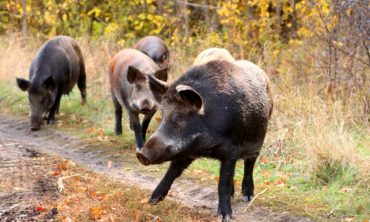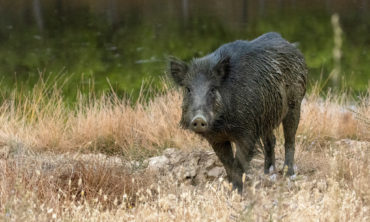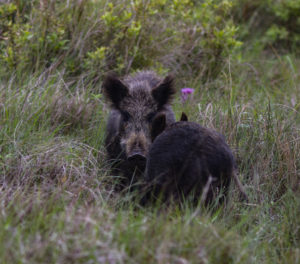
Feral hogs in North America are a non-native species introduced from Europe. These animals are commonly known as wild pigs, feral hogs, wild boars, razorbacks, wild hogs, and many other names. They come in a variety of colors and patterns, but regardless of the name used, they are all part of the same species: Sus scrofa. The species Sus scrofa includes the wild type, Eurasian wild boars, and domestic and feral pigs.
Origin of the Species
Genetic analysis of Sus scrofa and other Sus genera estimate that the Eurasian wild boar diverged from other members of the genus at the beginning of the Pliocene epoch (3.5 to 5.3 million years ago; Frantz et al 2013). Wild boars originated in Island Southeast Asia, and were able to expand across the Eurasian supercontinent. Separate lineages of European and Asian wild boars were identified by researchers using mitochondrial techniques, but it appears the species never diverged further.
Early Domestication

Free ranging practices were historically a very common method for raising swine in Europe and in North America. Photo of foraging wild boar courtesy of Dmitry Cherkasov.
Domestication efforts of the Eurasian wild boar began 9,000 years ago almost simultaneously in China and the Middle East. Domestication efforts in China were more similar to the domestic swine we see today, with penned livestock being fed scraps and refuse. These methods resulted in round, short legged pigs. Domesticated pigs in the Middle East were the origin of domestic swine in Europe. These pigs were allowed to roam and forage for their own food, a practice commonly known as free-ranging. This practice slowed the morphological changes of domestication, and allowed for interbreeding with free ranging Eurasian boars. As a result, the European domestic pig was still very similar morphologically and genetically to its wild counterparts. When European human populations began to grow in the 17th and 18th century, the space for free ranging swine decreased and demands for reliable food sources increased. During this time, domestication efforts in Europe drastically increased, and were expedited by hybridizing the free ranging European pigs with the rounder, more domesticated Asian pig. The hybridized pigs produced were bred for frequent and large litter sizes as well as faster weight gain; all characteristics valued in livestock. Today, all breeds of domestic pigs, excluding locally domesticated animals on the island of Sulawesi, can be traced back to the domestication of the Eurasian wild boar.
Pigs in North America
As Europeans began to explore the New World, the supplies they brought with them often included domestic pigs. At the onset of exploration, free ranging practices were still common in Europe and were replicated in the Americas where abundant food sources made it easy for pigs to feed themselves. The first documented introduction of pigs into the America’s was during Columbus’ second voyage in 1493 where he released pigs on to several Caribbean islands. Subsequent exploration expeditions and colonization efforts continued to bring domesticated pigs as a food source and often intentionally left pigs in an area so that there would be food sources for future expeditions. By the mid-1500s, pig populations on the islands in the Caribbean were so robust that they became the primary source of pig livestock for later Spanish expeditions.
One notable trip credited with numerous hog introductions was Hernando De Soto’s expedition across the southeastern United states from Florida to Texas. De Soto’s expedition was supplied with hogs from free ranging populations in Cuba. During his expedition, De Soto regularly left groups of pigs behind due to escape, capture, and so that there would be food sources for their return journey. De Soto’s expedition arrived in Texas in 1542, where they set up multiple camps losing pigs at each one. Other introductions were made to Texas by explorers traveling across land from the south. By the late 1500s wild populations of pigs were established in areas of Texas and in 1598 explorer Vicente de Zaldivar documented trading for pig by-products with Native Americans in Texas. As European colonization progressed, swine livestock continued to be a part of new settlements. Whether the settlements failed or succeeded, the free ranging pigs remained and continued to establish feral populations.
Early Conflicts
Free ranging domestic pigs and feral hogs provided an important food source to colonists. Unfortunately, the damage caused by hogs on the landscape is not a new phenomenon, and early settlers also had to deal with the damage caused by their free ranging livestock. Colonies in New Hampshire and Connecticut documented issues with pigs in the early 1600s. Husbandry at the time allowed pigs to forage for their own food, but instead of using native resources, hogs often damaged wheat fields, oat fields, corn fields, gardens, and grain storage. Conditions worsened to the point that the general court documented “[Much] hure, loss and damage doth accrue to this Common wealth and to particular person in the severall plantations, by those hogs that are kept or hearded in the woods, by theire rooting upp and wronging otherwise the common feed of cattle, and by their hanging around and breaking through fences . . . into mens corne and, and spoiling the same” (Trumbull 1850). Damage to food resources during a time period when starvation was a very real possibility seriously threatened the colonies and led to conflicts between farmers and livestock owners.
Colonial lawmakers attempted to address the issue by passing laws that required agriculture fields to be fenced in order for the hog owner to be held liable for the damage. Unfortunately this law did not diffuse tensions between colonists, and the situation escalated to the point that farmers in the New Haven colony went on strike in 1650. In order to appease all colonial groups, colony governments in both states passed laws that hog should be driven away from settlements to forage. This solved disagreements amongst colonists, but ultimately resulted in the hogs being moved on to lands owned by neighboring Native American tribes. Colonists expected free ranging hogs to be treated with the same respect other livestock received (i.e. not being killed because they are owned by someone else), even if they caused damage to Native American crops. New tensions escalated further when colonial governments ruled that the nearest Native American settlement would be held responsible for any killed or injured hogs whether or not they were responsible. These decisions, along with numerous other injustices, contributed to tensions that ultimately led to King Philip’s War between English settlers and Native Americans.
The historic practice of free ranging pigs continued to cause conflicts and damage for as long as it occurred. In the early 1600s the governor on St. George’s Island in the Bermudas authorized any man to kill and take away lose hogs “given the abuse and spoyle which ensued by sufferinge of hogges to goe lose, especially to the corne, sugar canes, and potatoes.” Free ranging practices eventually ended with the close of the open range, but populations of feral hogs were already widespread and continued to cause damage and conflict across their range. Even today, feral hogs are responsible for millions of dollars in damage every year. An important difference between the damage caused by feral hogs and free ranging domestic swine is that feral hogs belong to no one, are considered a nuisance animal, and may be managed as such.
Wild Boar Introduction
Pigs brought to North America during exploration and colonization were bought at a variety of domestication levels. Pigs brought to the new world during the 1500s were far more similar to their wild European counterparts than those brought in the late 1700s. The seasonal free ranging livestock practices of the time allowed newer breeds to continue to mix with their more feral counterparts creating a unique combination of the two groups. The origins of the feral hog in the United States were further complicated by the introduction of wild Eurasian boars in the late 1800s and early 1900 for hunting opportunities.
In 1898 wild boar originally captured in Germany were released at a game preserve in New Hampshire in 1889. These boar were the first of many hunting related introductions. Introductions across the country often ended with pigs escaping enclosures or being intentionally released onto the landscape. In Texas, wild boar introductions occurred in the 1930s and 1940s. Many of the notable Texas introductions used European wild boars purchased from zoos around the state. On a ranch in Aransas County, a feral hog sow was intentionally crossed with a European wild boar and the cross-bred offspring were released onto the property where they continued to reproduce and hybridize. A ranch in Calhoun County attempted to release wild boars purchased from zoos into an enclosure, but the boar escaped, reproduced, and traveled as far as Matagorda Island. In the early 1940s, another controlled introduction effort was made in Bexar County on a fenced property. Unfortunately, a large flood damaged the fences a few years later allowing the boar and their hybridized offspring to escape. These combinations of accidental and intentional introductions, and the resulting hybridizations, have created the invasive feral hog that we see on the landscape today.
Hog Expansion
The wild boar is a highly adaptable animal as shown by the diversity in its native range that stretches across the Eurasian continent. These animals thrived in the Americas and were able to quickly establish self-sustaining populations. As the centuries passed, their ranges have expanded dramatically from their original introduction locations and have had some help from humans too. Wild boar have been hunted in Europe for centuries and when the feral hog switched from a livestock classification to a nuisance animal classification in the United States, hunting interests became more popular here as well. In fact, hog hunting became so popular that vehicles were used to transport feral hogs to new locations to provide additional hunting opportunities (this practice is now regulated ). These transportation efforts allowed independent populations to pop up all over the map and greatly expedited the range expansion of this species.
For more information on current distributions of feral hogs, check out our Distribution page

